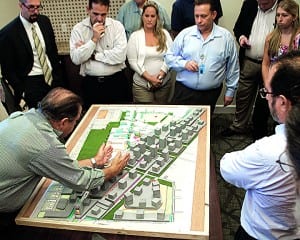
A possible future development plan for the village’s downtown district in the Franjo Triangle area was presented to members of the Palmetto Bay Business Association (PBBA) at their Sept. 5 luncheon meeting.
More than 100 local business owners, most of them also residents, viewed a presentation led by Building and Capital Projects director Ed Silva that unveiled some of the details of the plan, as envisioned by the village manager’s Downtown Redevelopment Task Force (DRTF), whose 40 members are in four subgroups: Planning and Architecture, Funding and Finance, Marketing and Business Incentives, and Landscape and Infrastructure.
A 3-D architectural model was unveiled providing a tangible, first-hand look at what Palmetto Bay’s downtown district could look like in 15 to 20 years. Silva explained the project and his enthusiasm for it.
“When our community works together, good things happen,” Silva said. “This is the largest, most diverse group ever assembled in village history toward one goal — to create a community hub and improve the quality of life for our residents. The stakeholders of this task force are truly demonstrating their commitment by dedicating hours of time and talent to this initiative. This is a very exciting time for our village.”
Lou Kallinosis, a business owner and resident who served as the chair of the Infrastructure and Landscaping sub-group, agreed with Silva.
“We have an exciting opportunity to make Palmetto Bay a more viable area to enter, a desirable downtown district that people want to come to, through our committee’s landscaping, traffic and infrastructure investigation,” Kallinosis said.
He pointed out that the project, in its infancy, and its overall financial commitment cannot be absolutely defined.
“But we do know it will predominantly require the private sector to make this whole thing happen,” Kallinosis said. “It will not be merely out of our pockets.”
According to Silva, the government’s role is important in this preliminary stage of development.
“We must change our sign from ‘Business- Closed’ to ‘Business-Wide-Open-and Readyfor- Investment,” Silva explained.
The first step involves village government making that possible with infrastructure and landscaping improvements and by removing regulatory roadblocks. According to Silva, the reason for the investment is to keep tax rates the same or lower in the future.
“Within five years the village’s deficit will be unmanageable, so the answer is to get a higher return from an expanded commercial base,” he said. “Tax bases will go through the roof. Residential folks will even get tax relief, even tax breaks as a result.”
Village manager Ron Williams said that the rationale behind the project is simple.
“Our role is to create the appropriate incentives,” Williams said. “We want the necessary investors to look at the entire picture to see if it makes sense for them to invest in Palmetto Bay, to see if they want to be a part of it, see if they can benefit from investment here, and even more importantly to see if their community can grow from it.”
The Franjo Triangle and Island district (FT&I), identified in 2006 after charrettes involving residents and business owners, set the tone and helped establish the location of Village Hall there, but little else has happened because of a lack of supporting infrastructure needed for new businesses.
“The famous line, ‘If you build it and they will come’ is alive and well in Palmetto Bay,” Silva said, pointing to other successful redevelopment initiatives throughout South Florida, including Delray Beach, Miami’s Midtown District, and City Place in West Palm Beach.
Remarkably, the project seems to have united many in the community who previously had divergent views on growth versus protecting the quiet enjoyment of residential neighborhoods.
David Zisman, an outspoken community activist, became the Planning and Architecture Sub-Group chair and is an enthusiastic supporter.
“Before I agreed to serve on this task force, I received assurance that we have full council support, that the initiative is funded and zoned properly, that we have support of the village manager, community support, and the neighborhood abutting the non-residential areas will be protected,” Zisman said.
“It is amazing to me how all the pieces of this puzzle are coming together. This is epic, this is what Palmetto Bay could be in the near future if we all get behind it and fund it and give the people who are going to develop it the pathway to do it right,” he added.
The project was approved in principal by the village council at the Sept. 9 budget meeting.
Groups interested in obtaining accurate up-to-date information regarding the downtown redevelopment initiative should contact Village Hall at 305-259-1234 to schedule a presentation by village staff and task force members.






